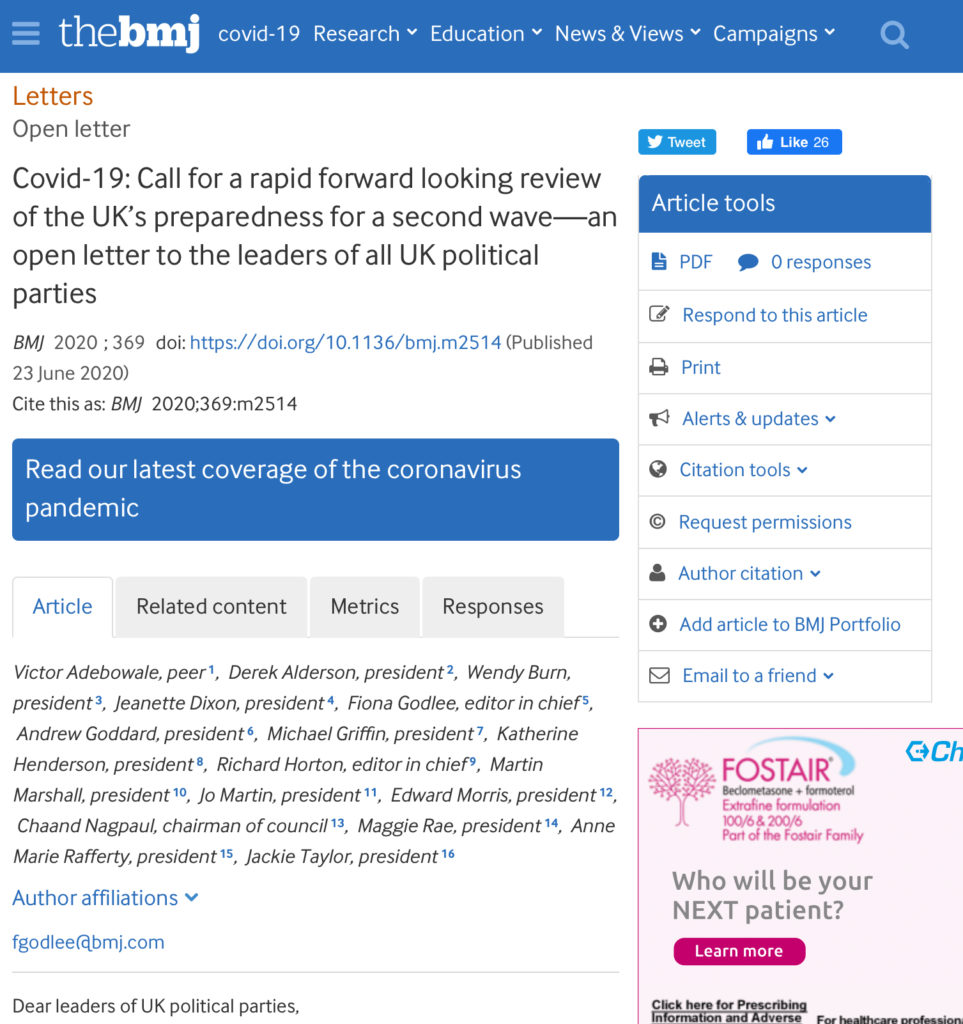Liz Stanley
A consortium of the leaders of the UK‘s medical, nursing and public health professions on 24 June published a joint letter in the British Medical Journal, sent to the leaders of all UK political parties. It argues for procedures to plan for what happens next, now that strict lockdown has been lifted, because in their view the possibility of a second wave of coronavirus is actually likely rather than just possible. Succinctly, it proposes a cross-party all-interest group or inquiry but which would have planning for what happens next as its aim, rather than enquiring into what went wrong with the first wave of the coronavirus pandemic. It proposes that the focus for this inquiry should be:
- “Governance including parliamentary scrutiny and involvement of regional and local structures and leaders
- Procurement of goods and services
- Coordination of existing structures, in a way designed to optimise the establishment of effective public health and communicable disease control infrastructure, the resilience of the NHS as a whole, and the shielding of vulnerable individuals and communities
- The disproportionate burden on black, Asian, and minority ethnic individuals and communities
- International collaboration, especially to mitigate any new difficulties in pandemic management due to Brexit”
Important in its own right, there are a number of aspects worth thinking about in a bit more detail.
First, there is the fact that these professions are working together and doing so through the highly regarded vehicle of the BMJ. The medical, nursing and public health professions are all important, but in worldly and political terms the most powerful of these is the medical profession. The BMJ is a kind of lodestar, with social scientists as much as others working within medical areas aspiring to publication even as one of a very large team in its pages.

Second, the letter is addressed to the leaders of all political parties, not the government specifically or at least not in a public way in this letter. This is itself a sign of the changing times, for even just a few weeks earlier it would have been addressed to the government or some part of it. It is a return to political life that is being signalled in who the letter is addressed to, in which political debate and manoeuvering will resume publicly, for one assumes it had not entirely gone away out of the public eye.
Third, the leaders of the medical, nursing and public health professions have used a letter, a public open letter, to make their intervention. In academic terms, much has been pronounced (wrongly) about the so-called death of the letter. Against this, not only is there a massive upsurge in forms of communication premised on ‘letterness’ aspects, text and email amongst them, but in formal circumstances it is notable that only a written letter directed to a known person and physically signed by the letter-writer will do for legal, official and other public purposes. Using a public letter as the device of communication is a strong signal of intent on the part of identified persons, with their names and positions specified as part of ‘the letter’ overall, which includes its address and sign off as well as its specific content.
And fourth, in the BMJ letter the way that what happens ‘next’ appears is that this might well be rather like previously, unless problem areas are tackled and better forward thinking mechanisms put in place. ‘The future’ is described as ‘the future state of the pandemic’ and the letter is concerned with planning for this. It is notable that there is no sign of an ‘after‘, in the sense of the pandemic coming to an end, of this being a possible state that UK society will be in. Instead there is next, a haunting by a possible future that could be as terrible as what has happened already.
